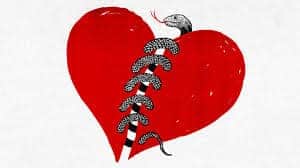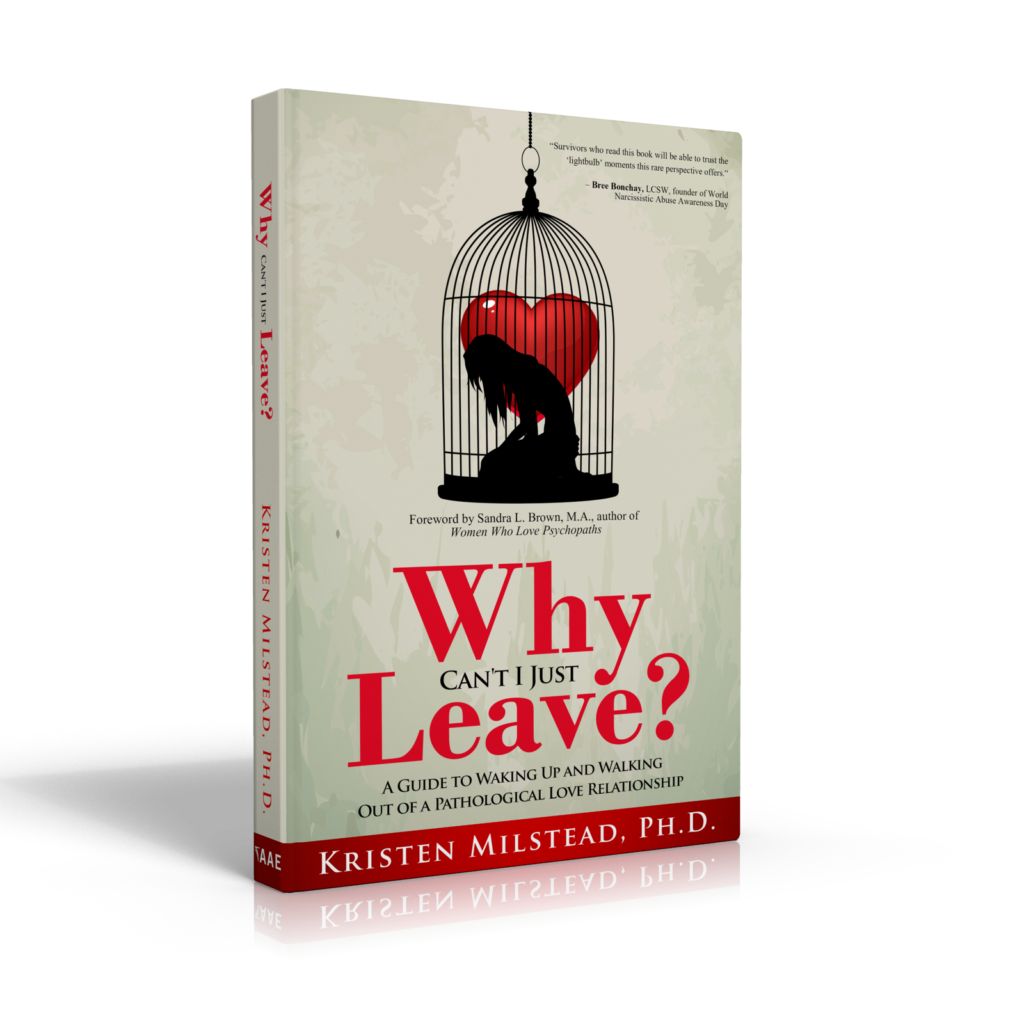Part of the reason why it’s so hard to break up with a narcissist is that the abusive dynamic with a narcissist is formed through a series of mostly small interactions over a long period of time.
Those interactions affect us in many ways and the reasons why we stay bound to our narcissistic partners even when we want to leave become complicated.
Here are six important concepts that explain narcissistic abuse in relationships.
Why We Can’t Break Up with a Narcissist

The methods narcissists use are the same ones advertisers use, the same ones casinos use to entice visitors to keep gambling away their cash. They are the same tactics criminal investigators use on suspects.
The methods show the psychology behind why it is so difficult for people to change their beliefs even when they are shown evidence that those beliefs are blatantly false. They show how propaganda works.
And yet we keep asking why their partners don’t just leave.
1. Intermittent Reinforcement
One day, he or she is loving and kind and the next, he or she is cruel and dismissive.
Experimental studies conducted on rats by behavioral scientists determined that the most effective schedule for producing desired behavior was an unpredictable one.
When the rats received a pellet of food every time they pulled a lever or at predictable times, they were less likely to do it because they always knew what to expect.
In terms of abusive situations, we are more likely to keep going back to or staying with the abuser if we aren’t sure how he or she is going to act from moment to moment. The narcissist provides “rewards” for behaving as groomed during the love-bombing stage, and punishments when you do not, such as when you challenge a narcissist’s lies. The punishments can take the form of raging, silent treatments (disappearing for long periods of time), threats, smear campaigns, hurtful comments, and others.
Shannon Thomas writes in Healing From Hidden Abuse, “Intermittent reinforcement is basically how people are brainwashed… This sort of conditioning trains survivors to anxiously anticipate when abusers will intermittently reinforce the connection between the two individuals. There is no rhyme or reason to their level of attention or affection. Sometimes it is based on the survivor playing by the abuser’s rules. Other times, abusers do not respond in the way that would have been expected.”‘
This is not something that survivors of abusers just “fall for” because they are a unique category of individuals who got involved with abusers or even just because they are being abused. This is a psychological principle that affects us all.
The same concept keeps people in casinos pumping money into slot machines, or even checking Facebook for comments or checking their E-mail to see if they have received any.
2. Biochemical Dysregulation in Our Brains
Another reason that makes it difficult to leave narcissistic abusers are the biochemical bonding disruptions, which Shahidi Arabi (p. 165-174) describes in Becoming the Narcissist’s Nightmare.
The hormone oxytocin and the neurotransmitter dopamine cause positive feelings to flow throughout the brain and body and promote bonding with others. These become dysregulated and synced up with the intermittent reinforcement of the narcissist’s behavior.
For example, dopamine “flows more regularly when rewards are given on an unpredictable schedule,” such as when an abuser explodes after the survivor has been walking on eggshells or disappears with a silent treatment only to return and pretend as if nothing has happened.
3. Learned Helplessness
The trauma of the abusive relationship also changes the structure of the brain to have other effects as well.
Sandra L. Brown, author of Women Who Love Psychopaths (p. 224) writes that in some relationships, “the women are too impacted by Post Traumatic Stress Disorder (PTSD), depression and other symptoms to be able to initiate and carry out the disengagement process which requires a level of functioning she does not currently have.”
(Please note that her conclusions are general enough to apply to all individuals who have been in relationships with psychopaths and I am using them as such).
There are important reasons why PTSD and other mental health issues have this effect.
As Arabi (p. 162-63) also states in Becoming the Narcissist’s Nightmare, this is because traumatic memories stay lodged in the areas of the brain that are responsible for executive functioning. These are the areas that are associated with logical tasks that require reasoning and planning.
The result is that these areas of the brain shrink and stop functioning in the manner they once did, sometimes shutting down.
The women instead become “paralyzed,” and unable to do anything because of the trauma.
In experimental studies, dogs that were caged and repeatedly shocked when they tried to escape gave up trying and became so traumatized that they didn’t even try to escape when they were given the chance.
This mindset is called “learned helplessness.”
It’s an adaptation to trauma that results due to changes to brain structure that make it difficult for a person to function as they would if they could access and use all areas of their brain at a normal capacity.
4. Stockholm Syndrome and Trauma Bonding
A trauma bond is one in which a person develops loyalty to a person who is harming them. The bond is created when the narcissist repeatedly comes into the victim’s life and alternates between performing traumatizing and loving acts. This keeps the victim tied to that person with an elusive promise of a future where the harm will stop.
Yet each period of kindness is another false start. The victim lives in a state of perpetual misery because he or she is always waiting for the future that never arrives. Only the narcissist can rescue them from their pain, despite the fact that he or she was the one who caused it in the first place.
In the book Women Who Love Psychopaths (p.227), Brown writes, “Many of the women have the same symptoms seen in other types of conditions associated with emotional manipulation or psychological torture such as Stockholm Syndrome, cult programming, psychological warfare, coercion, mind control, and trance logic thinking.”
She describes how psychologically the women experience the four dynamics of Stockholm Syndrome:
(1) perceiving a physical or psychological safety threat that the abuser is able to carry out;
(2) unconsciously seeing her abuser as vulnerable and letting down her guard when he acts in kind ways;
(3) undergoing a change in thinking that becomes delusional.
This happens because he is able to distort her reality by indoctrinating her with his pathological worldview while simultaneously isolating her from outside perspectives that would challenge his ideas; and
(4) developing a perspective that she is unable to leave because the abuser has convinced and conditioned her through various tactics that she cannot escape from him.
All of these things work together to keep the survivor “on the abuser’s side.”
We as survivors develop a loyalty to the very person who is hurting us called a “trauma bond.”
We hide their abuse, find ways to rationalize their abusive behavior, focus on the positive connection and do what we can to try to stay in their lives, and have irrational thoughts about how we are forever tied to them.
5. Identity Erosion
A long period of time in the relationship leads to identity erosion. Our personalities slowly start to change from what it was prior to the relationship.
Jackson MacKenzie includes an entire chapter in his book, Psychopath Free, about identity erosion, in which he describes the multitude of tactics narcissists use that erode the identities of their partners (p. 38-83).
These include (among others):
- manufacturing emotions that otherwise wouldn’t exist by saying or doing dramatic, confusing or untrue things to provoke those reactions;
- ignoring boundaries until we do things we never thought we would do; and
- using a combination of conversational tactics to make us feel fearful of expressing ourselves because of how the narcissist will react.
Narcissists also begin to criticize the very characteristics of the partner that he or she once praised. Where once the narcissist exalted and complimented, now he or she demeans and humiliates, holding back none of the contempt.
Partners of narcissists learn how to confine and smother a large part of their personalities and respond in new, unfamiliar ways that are unlike they would normally respond.
Then the narcissist implants themselves in that spot where the lost identity has been drained away.
The narcissist’s preferences, needs, and desires now control and motivate that aspect of his or her partner, convincing the partner that this relationship is what he or she wants.
6. Cognitive Dissonance
Almost since I began this blog, I have been writing about how narcissists split us in two, as we try to decide: is the narcissist “good” or “bad?”
The technical term for this is cognitive dissonance, which is the mental anxiety felt when we hold two conflicting beliefs.
We resolve them by coming to a conclusion somehow about which one is correct by rationalizing, ignoring evidence, denying, or some other psychological mechanism.
With cognitive dissonance, usually, the belief or idea we encountered first is the most resistant to change, as it is older and provided the foundation for so many other of our beliefs afterward. It makes more sense.
Narcissists literally show us two people–the one who was our soulmate at the beginning and then morphs into the one who holds us in contempt, looks at us with hatred, and does things to us you didn’t even know people would be capable of doing to their enemies.
Cognitive dissonance literally becomes a mindset, the dominant state by which we filter all stimuli.
Yet cognitive dissonance causes us not to be able to see the narcissist clearly.
The stage for it is set almost immediately with the love-bombing we receive at the start of the relationship. Though the other five things that help explain narcissistic abuse in relationships are very important, they develop over time.
Cognitive dissonance, however, begins with the first negative incident and precedes all of the other five things that help bind us to our partners. In fact, cognitive dissonance is what straps us in place so that the other five can take hold.
It can also linger after the relationship ends.
Once we go no-contact with our partners, we are left trying to piece together what happened, how so many actions that did not align could have taken place.
They can keep us guessing about whether the abuse took place and our role in it, the same lack of awareness or denial that has existed since the first moment we entered the relationship:
“What makes psychopathy so different, so surreal, so much like a relational bitchslap that it nearly knocks her head off?
- The sensation of being emotionally ‘jumped’ from behind.
- The inability to wrap her head around the emotional-physical-spiritual-sexual gang-bang that just happened when she thought she was with the most wonderful person.
“No one can figure out how a dangerous psychopath curled up to them like a purring cat. Half of recovery is just trying to figure out ‘what was THAT?’ The longest portion of therapy is always helping the woman understand ‘what’ the psychopath is. What he does, how he feels, how his brain thinks, what he says, what is that his core– all these traits are far outside the average person’s experience. To understand what happened to her she must learn to understand his peculiar traits” (Brown, p. 49).
To truly break up with a narcissist psychologically even after the relationship ends, the cognitive dissonance must be overcome.
These instincts were activated and then conditioned to work against us so that we could be potentially exploited forever.
Enjoying this post? Please take a moment and subscribe to this blog to get all future articles delivered to you before continuing to read below. Thank you!
Don’t forget to check out these resources on the website while you’re here:
- Taking Your Life Back After a Relationship With a Narcissist (Free ebook)
- Comprehensive Narcissistic Abuse Dictionary
- Narcissistic Abuse Resources for Recovery
Sources
Arabi, S. (2015). Becoming the Narcissist’s Nightmare. New York: SCW Archer Publishing.
Brown, S.L. (2009). Women Who Love Psychopaths. Minneapolis, MN: Mask Publishing.
Mackenzie, J. (2015). Psychopath Free. Berkeley: Penguin Random House.
Thomas, S. (2016). Healing from Hidden Abuse. Tempe, AZ: MAST Publishing House.






38 Comments
Brittnee
Your work is incredible. You have helped me tremendously. I really appreciate all that you have done for all of us. Thank you so much. Brittnee
B Trayed
DROP THE SHE IN THIS ARTICLE !!!!!!!!!
STOP THE ASSUMPTION THAT THE MAN IS THE NARC AND THAT SHE IS THE SURVIVOR !!!!!!!!
THE ONLY NARCISSISTS I KNOW ARE WOMEN !!!!!!!!!!
Kristen Milstead
I don’t make assumptions here, B Trayed, and I’m sorry for your experiences, however, I am the administrator of this website and I have chosen to represent my own experiences because they are mine, and I am now a healed survivor and I no longer take to the demands of others very well. I also never found or find offense when I see other survivors writing with pronouns that don’t pertain to my experience– I am still able to relate and I find it puzzling that you are unable to do the same. It’s interesting that you’re unable to put yourself in my shoes because I am a woman unless I write from the general and use a vague pronoun even if our experiences are similar. Why is that? That is something for you to stop and ask yourself, but it is not something for me to change… If you are offended by this, you are free to stop reading. Thank you for stopping by. -Kristen
Jeanette Hager
I didn’t know that I was married to a narcissist, and not just once but twice. I discovered my first marriage to a covert narcissist only after I discovered my second marriage was to a vulnerable narcissist or I could diagnosed him as a malignant narcissist. After my divorce, I went into that linger cognitive dissonance as she described in her post. I felt like I was on drug withdrawal, lost a lot of weights, insomnia and extremely confused for two months. I found a cure to get out of that cognitive dissonance, I want to share this wonderful discovered treatments. It’s all about our hormones in our brains. These are the supplements I took daily and I recovered after 2-3 months. 1) Supper B complex, Vitamin B5 combines with Calcium and Magnesium, 5-HTP 200 mg combines with Vit. B6, and Ashwagandha with hot water. Vitamins B complex supports brain health, Vit. B5 alleviate anxiety, 5-HTP ( serotonin and dopamine release- happy hormones). These are wonderful supplements that everyone should take, even if you have never experienced with narcissistic abuse. I didn’t take my two ex-husbands personally, unfortunately, they were abused by their own narcissistic mothers. I have a daughter with my first marriage, I was able to safe her from her father’s narcissistic abuse, I got her full soul custody. How? I used money to leverage him. That’s all he cares, money!
Thank you for the post, such a well-written on the diagnose of the narcissistic abuses.
Kiten
Absolutely-on-target. I fell into it and never understood “intermittent reinforcement “ and cognitive dissonance and how those , paired with my own lack of self love and then add on top alcohol ?- And you get the perfect cocktail to get addicted to a crappy relationship. It took a long time for me to untangle my head. Like two years… And I knew it was messed up probably within six months to a year I was addicted… Not in love.
Gerry Rigley
I am at present living a nightmare with the court that gave me the divorce, they have continuously ignored the many factual documents I have given them that clearly show my ex for what she is, A thief, a habitual adultress, a liar and too many other things to put here, she just ran off one day to be with her new victim, removed every penny from my personal account leaving me destitute with six dogs to feed and our house to maintain, her solicitor is as bad as she is and seems to run the court and the judges, I have just written to the court again today, if anyone would like to see my letter please write to me and I will happily share it. I am so depressed, my dogs are the only things that stop me from taking the cowards way out, I am happy to see that I am not alone in this cruel sea of sadness. Good luck and love to everyone…. Gerry
Alex
Keep on keeping on. There is always hope that life will improve now you are rid of her. Who knows what wonderful experiences yo life might have now you are out of her control.
Ruth
My sincere thanks to you for this article, I left my 22 year marriage two months ago – (I had been trying to acquire the courage to do this for 10 years) It was very difficult for family and friends to understand this fear, and this article superbly explains the psychological and physical response to such stealthy malignant abuse. Everything that you wrote, hit me like a “brick”, especially the section on learned helplessness – the experimental studies of the dogs blew my mind! THAT WAS ME!!! Petrified to leave, and knowing that if I stayed, I would not survive much longer. Day by day, I am getting stronger, and and your words are part of that success – again I thank you! *I had a good laugh over something with my sister-in-law and my niece the other day, and they both looked at me, and so “Oh, how wonderful to hear you laugh again!”
To anyone out there that is afraid, hang on – learn as much as you can! When you educate yourself, you become stronger, braver and slowly but surely, you become yourself again!